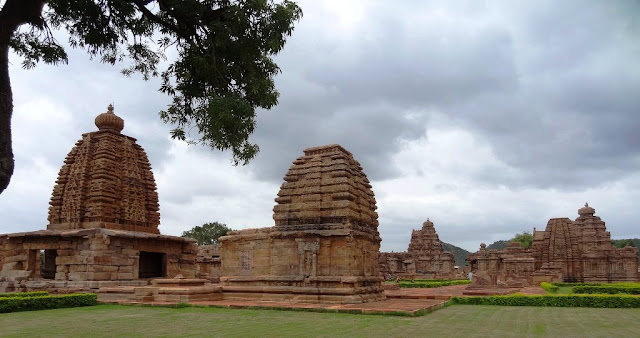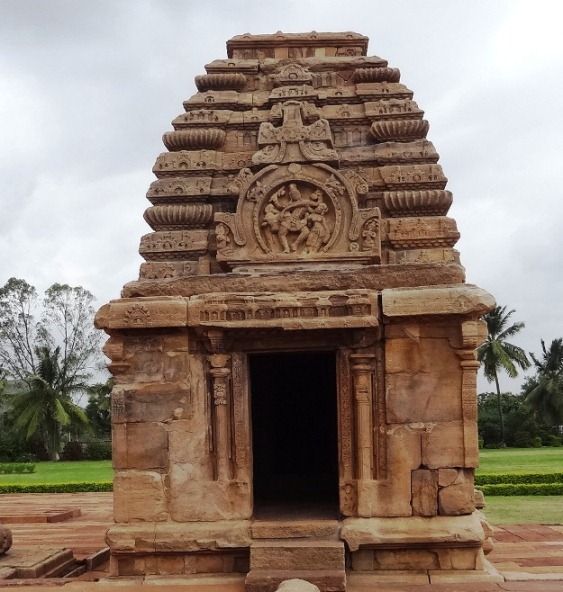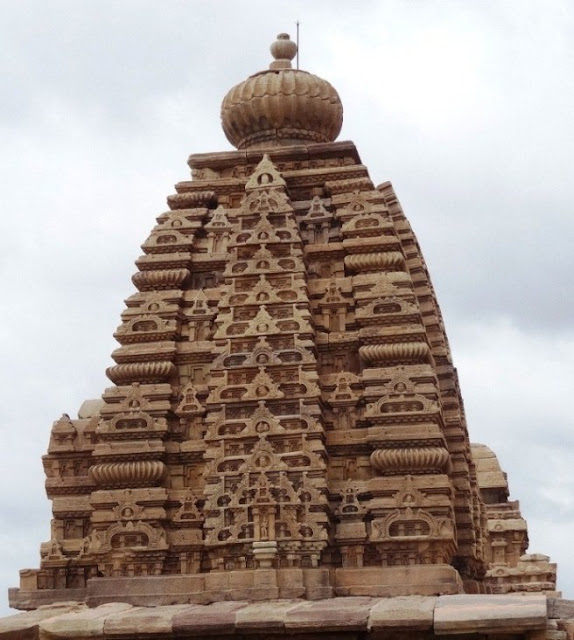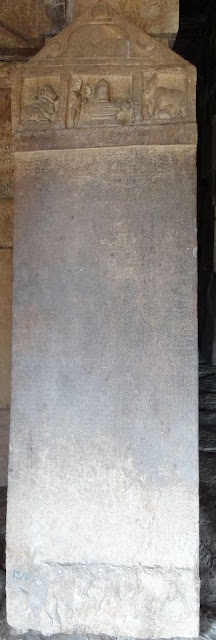Pattadakal is a famous archaeological site in South India and also a UNESCO World heritage site. It is located at 22km from Badami, in the Bagalkote district in Karantaka. Temples at Pattadakal was built during 650-750 AD. They are the culmination of great Chalukya art and architecture. There are around 9 temples in the Pattadakal complex, which represent the evolution in Chalukya architecture.
All temples in Pattadakkal complex are consecrated to Lord Shiva. They stand elegantly facing east on the bank of River Malaprabha. As we enter into the Pattadakkal complex, a pleasant sight of beautiful red sand stone temples standing in the landscaped lawns welcomes us. Pattadakkal temple complex is a UNESCO world heritage site and it enjoys an international status.
However, things were not same in the past. A quick look at the photo museum near the ticket counter shows not-so-beautiful pictures of Pattadakkal temples. Earlier, village houses were built in the middle of these temples usually encroaching and destroying the valuable cultural edifices. In 1972, the Archaeological Survey of India took charge of Pattadakkal and tried to evacuate the villagers which caused a slight tension between the department and locals. The photos in the museum shows the restoration procedures as well.
After taking the tickets, we entered into the Pattadakkal complex. The first temple that a visitor encounters is the Kadasidheshwara temple.According to Archaeological Survey of India(ASI) this temple was built around 650 AD. One should note that the names of these temples are not the ones used in ancient times. Nobody knows the ancient names of these temples with high degree of confidence.
Kadasidheshwara temple Pattadakkal
Kadasidheshwara is a Nagara style temple. Dravida and Nagara are two styles of temple architecture in India. Dravida style was mostly practiced in South India where as the Nagara style was practiced in North India. Our guide explained us about a third style, locally known as "Vesara" style. In old Kannada Vesara means mule. As the new building style is a cross between the Dravida and Nagara styles, the new style is known as the Vesara style!An expert in architecture can find numerous differences between the Nagara and Dravida style architecture. But for an armature like me, the most striking difference is in the construction of the temple tower. Dravida architecture has a stout tower with distinct blocks and ends in a pot shaped finial. The Nagara style has gradually diminishing lean tower with intricate carvings ending in lotus shaped finial. Temple tower of Kadasiddheshwara has the features of Nagara style even though the finial on top is missing.
As we entered into the Kadasiddheshwara temple, our guide was trying to explain to us the importance and symbolism of the Idol of Shiva (In Linga form) and how the plinth of the Idol represented represented the holy trinity of Hinduism. The plinth has a square base representing Vishnu, on top of that there is an octagonal shaft representing Brahma, the round Linga represent Shiva. (Generator, Operator, Destroyer (means GOD)... in our guide's own discovery)
The Kadasiddheshwara temple has a steadily diminishing tower of Nagara style. There are bands with Gavaksha carvings in the center. The finial on the top is however, missing. One of the important features of the Kadasiddehswara temple is the perforated windows with Swastika designs.
Jambulinga temple - Pattadakkal
The next one is the Jambulinga temple which is situated quite close to the Kadasiddehswara temple. It also looks quite similar to the Kadasiddehswara temple. However on a closer look one can see that the tower is much leaner. Jambulinga temple is also built around the same time period as the Kadasiddheshwara temple. (Around AD650). Both of these temple shows an experimental stage in the development of Nagara style temple architecture.
Galaganatha temple - Pattadakkal
The first two temple requires less time as compared to the next one. The Galaganatha temple. It is located towards south of the Jambulinga temple. Galaganatha temple seems to be ruined or just partially constructed. However the Nagara type tower of the temple is perfectly preserved.
There is a fully finished Amalaka finial on the top, in addition to the Gavakasha motifs. Galaganatha temple, which was built around AD 750 shows great progress in the Nagara style architecture over the Kadasiddheshwara and Jambulinga temples.
There are quite a lot of stone platforms can be seen to the south of the Galagnath temple. They were originally smaller shrines, of which plinth only survived. One would be perplexed by the number of temples in such a small area. These temples were commemorative in nature. Pattadakkal was the place were the Chalukyan kings were crowned. This was an elite place for the same reason.
Also the red color sand stone was plenty in this area. For the same reason Pattadakkal was known as "Kisuvolal" in ancient days. "Kisugallu" in Kannada means Ruby and "Hollalu" means city. Hence "Kisuvolal" literally meant the Ruby city. Later years, Kisuvolal also came to be known as "Pattada Kisuvolal" - meaning the ruby city where the Kings are anointed. In recent years the archaeologists have discovered an ancient quarry near the Pattadakkal site. They found inscriptions, signatures and random art by ancient workmen in the quarry. Most probably, the stones for Pattadakkal temple was brought from the same quarry.
Chandrashekhara Temple - Pattadakkal
Quite close to the Galaganatha temple, there is the a small temple devoid of any tower. It is known as the Chandrasekhara temple. ASI assigns year 750AD as the construction period of this temple. However there are varied opinion among the experts.
Sangameshwara temple - Pattadakkal
To the south of Galaganath temple stands the huge Sangameshwara temple. This temple might be the
earliest Dravida style temple that the Chalukyas erected at Pattadakkal. It was built in the
first few years of 8th century by King Vijayaditya (696-733 AD). This temple was consecrated to Vijayeshwara - the deity named after the patron of the temple. This colossal temple was not completed, probably due to the death of its King Vijayaditya in 734AD. The sculptures in many niches
around the walls of the temple are incomplete. There are evidences that this
temple was attempted to complete during the Rashtrakuta times. The 16 column
Mantapa in front of the temple is an addition during the Rashtrakuta times.
Sangameshwara temple is
especially notable for the donation inscriptions. One goes like this:
“Swasti shree Vijyaditya natya dasi Challabee ne kamba mooru”
It is an ancient Kannada script describing the donation of 3 pillars
to the temple by the dancer named Challabee. It is also notable that Challabee
is a lady. Another similar inscription describes that 51 gold coins gifted by a
business women "Bhootam" who
was addressed as "manomathe bhootam" in the inscriptions. These inscriptions
also shed light to the possibility that, the temple might have been an
Royal-Commoner partnership project. There were always rich patrons among the
public who wanted to gain spiritual merit by donating to these temples.
Sangameshwara temple is also notable for the inscribed slab inside the temple. It dates from much late 1163 when
the Kalyani Chalukya king Talia III and his subordinate Chavundaraya from
Sindha family visited this temple. It registers a gift of land to the lord
Vijayeshwara and it was made over to the Acharya of the temple (chief
priest/scholar) Suryabharana-Panditadeva.
There is an interesting piece of sculpture inside the temple. It is indeed a series of Lotus flowers carved on the ceiling of the temple. As we move towards the inner sanctum, the complexity and the beauty of the lotus sculpture increases. It might be a demonstration of the evolution of the sculptural techniques. Also concurs with the idea of a devotee attaining higher merit as approaching the sanctum.
The tower and the outer walls of Sangameshwara temple are
intact. Some of the carvings on the outer wall niches are incomplete. However
the tower is prefect with a pot like finial on the top. The travelers can find
a striking difference between the Dravida and Nagara style towers which are
placed so close to each other. This is the main advantage of Pattadakkal. One
can clearly see the evolution of Indian temple making techniques.
Inscribed stone pillar at Pattadakkal
The octagonal stone pillar in the center of the site is a source of
great deal of information. It was erected by Kirtivarman II depicting the
history and exploits of his ancestors. It gives information about the
Sangameshwara temple, erected by Vijayaditya, and also about the Mallikarjuna
and Virupaksha temples which were erected by the queens of King Vikramaditya 2. It also praises the military expeditions of Vikramaditya II to Kanjeevaram in Tamil Nadu and thus defeating the Pallavas.
Virupaksha Temple - Pattadakkal
The biggest and most elaborate temple in the Pattadakkal complex is the Virupaksha Temple. Originally the deity was known as Lokeshwara named after the chief patron of this temple Queen Lokamahadevi. She was the senior Queen of Vikramaditya II. According to the inscription on the octagonal column at the center of the Pattadakkal site, Virupaksha temple was built to commemorate the victory of Vikramaditya II against the Pallavas and conquering Kancheepuram in 745. Most probably the temple construction was started after 745, which is the reason for highly evolved architecture and sculptures present inside the temple.
Located in a perfect East-West direction, Virupaksha temple is temple comprising of 9 different elements. As all the elements of a perfect temple is intact, regular worship is conducted in the temple even today.
1. Garbagruha
2. Antarala
3. Pradikshana Path
4. Thri garbhagruha (trikuta temple)
5. Sabha Mantapa or dancing hall / Navarang
6. Mukha Mantapa
7. Nandi Mantap
8. Mahadwar
9. Malaprabha River
There is no exaggeration in saying that Virupaksha temple is the culmination of Chalukyan art and architecture. This temple is an epitome of Dravidian architecture. It's outer walls are carved with extensive sculptures and ornamental designs. The outer walls have numerous niches housing numerous sculptures of 6 armed Vishnu in Trivikrama posture, Shiva emerging from a
linga amidst of the flames, 8 armed Shiva standing on a dwarf, Shiva and
Parvati on an affectionate embrace, Narasimha disemboweling his victim, Ravana
shaking Kailasa, scenes from Ramayana also are depicted like vali and Sugreeva
in a fight, Ravana abducting Seeta etc.
It would take hours together to go through each of these sculptures in details. These outer walls have perforated windows as well one of them was of great interest to me. It is the image of two-headed mythological bird, which was the official emblem of the Wodayars of Mysore and also appears in the official seal of Karnataka state. Another window features intricate ropes and snakes tangled in beautiful designs.
The total height of the tower of Virupaksha temple is 17.5
meters. It is the highest of any Chalukya style temple. The temple is in
perfect Dravida style with a tower of three abruptly diminishing steps finished
in a pot shaped finial.
The entrance of the temple is on the east side with a raised porch. The porch sculptures of guardian figures Bhadra and Veerabhadra leaning heavily on their clubs. Also close by there is Shankha-Nidhi and Padma-Nidhi the Counch and Lotus wealth bearers indicating the prosperity.
On the porch ceiling one can find a beautiful carving of Sun God Surya riding his chariot, accompanied by his consorts Usha and Sandhya (Dawn and Dusk) respectively.
On the porch ceiling one can find a beautiful carving of Sun God Surya riding his chariot, accompanied by his consorts Usha and Sandhya (Dawn and Dusk) respectively.
Through the porch, one enters into a grand pillared hall( Maha Mantapa). The 18 pillars in this hall is rich in carvings. Each of these pillars tell a stone carved story, mostly from the epics Mahabharata and Ramayana. The carved story starts from one side of the pillar and continues to the next side and the next. It is only with the help of qualified guide, one can understand and appreciate these stories.
I did try to understand a few of them:
1. Churning of the Milk ocean for Amrut
It is the story of Devas and Asuras join together to churn the milk ocean. The Devas and Asuras are depicted as tugging Sesha Naga(the serpent of Vishnu) who is wrapped around the Mandara Parvata(Mount Mandara) as an anchor. Precious artifacts emerges from the milky ocean such as Kamadhenu, Airavat, Lakshmi Devi and eventually the pot of Amrut (the nectar of eternity)
2. The Ramayana story
The scenes from Ramayana starts with Lakshmana cutting the nose of Shurpanakha, who complains to his brother Ravana. Subsequently Ravana abducts Seeta to Lanka. Hanuman jumps to Lanka and meets Sita with the message from Rama and Hanuman depicted as sitting on his coiled tail, at a heigher position than Ravana. Finally Hanuman sets fire to Lanka
3. Mahabharata story
The game of dice and Pandavas loses the game. The great battle of Mahabharata ensues, Bhishma lying on a bed of arrows, the rest of war story continueing on to the other faces of the pillar. Like the fight between Karna and Arjuna and Bhima and Duryodana vigourously fighting using clubs.
4. Kiratarjuneeya
Arjuna and Shiva(disguised as Kirata) aims at the same boar and starts an argument about who acutally shot down the boar. A battle startes between the two and Arjuna overpowers Shiva. Pleased in Arjuna Shiva gifts his magical axe and Arjuna continues his journey on the other faces of the pillar.
I did try to understand a few of them:
1. Churning of the Milk ocean for Amrut
It is the story of Devas and Asuras join together to churn the milk ocean. The Devas and Asuras are depicted as tugging Sesha Naga(the serpent of Vishnu) who is wrapped around the Mandara Parvata(Mount Mandara) as an anchor. Precious artifacts emerges from the milky ocean such as Kamadhenu, Airavat, Lakshmi Devi and eventually the pot of Amrut (the nectar of eternity)
2. The Ramayana story
The scenes from Ramayana starts with Lakshmana cutting the nose of Shurpanakha, who complains to his brother Ravana. Subsequently Ravana abducts Seeta to Lanka. Hanuman jumps to Lanka and meets Sita with the message from Rama and Hanuman depicted as sitting on his coiled tail, at a heigher position than Ravana. Finally Hanuman sets fire to Lanka
3. Mahabharata story
The game of dice and Pandavas loses the game. The great battle of Mahabharata ensues, Bhishma lying on a bed of arrows, the rest of war story continueing on to the other faces of the pillar. Like the fight between Karna and Arjuna and Bhima and Duryodana vigourously fighting using clubs.
4. Kiratarjuneeya
Arjuna and Shiva(disguised as Kirata) aims at the same boar and starts an argument about who acutally shot down the boar. A battle startes between the two and Arjuna overpowers Shiva. Pleased in Arjuna Shiva gifts his magical axe and Arjuna continues his journey on the other faces of the pillar.
Also many scenes from the daily and courtly life is carved onto the pillars. One of the favorite of the guide is the lady carrying a vanity bag.
There are also scenes of battle richly depicted on the columns.
The sanctum of Virupaksha temple houses an ancient Linga. Mere the feeling of standing inside a 1400 year old monument gave me goosebumps. I have been to many temples, but believe me, Virupaksha temple has a magic of antiquity.
Once we exit the porch of the Virupaksha temple we encounter the grand Nandi Mantapa. Nandi is the vehicle of Lord Shiva. It is customary of Indian temples to place the image of the vehicle just in front of the temple.
The colossal Nandi(3 meters long and 1.8 meters high) is made of granite. It is sculptured so naturally that even the folds of his skins are beautifully carved. There are no extra decorations but the black granite stone has survived for more than a thousand years. It is the same stone with which the Linga idol inside the sanctum is made of.
Beyond the Nandi Pavillion one can see the original gateway of Virupaksha temple. This gateway was used as an entrance to the Virupaksha temple, to approach it from the Malaprabha river. The inscriptions of the chief architects of the Virupaksha temple is inscribed also on the gateway.
Mallikarjuna Temple - Pattadakkal
Close to the Virupaksha temple stands the Mallikarjuna temple. Both the temples are quite similiar it their plan. Trailokamahadevi, the queen of Vikramaditya II was the chief patron of Mallikarjuna temple. She is believed to be the twin sister of Lokamahadevi. The temple is dedicated to Shiva as Trailokeshvara. Even tough plans of both the temples are similar, Mallikarjuna temple looks either incomplete or heavily ruined.Just like the Virupaksha temple, Mallikarjuna temple also has Mantapa pillars carved with many stories. Apart from stories of Mahabharata and Ramayana afore mentioned, Mallikarjuna temple has depicted stories from Panchatanta and also about the daily lives of people
1. Mangoos and Snake story
2. The monkey getting trapped
3. The lady who is taking a sun bath
4. Lady looking in her mirror
5. Elephants fighting and punishments.
Papanatha temple Pattadakkal
Right next to the Mallikarjuna temple stands the Kashi Vishwanatha temple. It is by far the most complete Nagara style temple in the complex. It might have been built during the first decades of 8th century. It has the most intricate tower design among the Nagara style temples in the complex. However the Amalaka finial on the top is missing in this temple.
The last temple worth mentioning in the Pattadakkal complex is the Papanatha temple. It is located around 100 meters from the main temple complex. It is probably the last temple built by Chalukyas in the Pattadakkal area. Papanatha temple exibits a mixed style of Dravida and Nagara. In the local tongue it is known as Vesara style.
The tower of Papanatha temple is that of Nagara style. One of the interesting features of Papanatha temple is two interconnected mantapas. The mixing of Dravida and Nagara style is done with such skill that, it is difficult for an untrained eye to distinguish the two of them. However a trained guide can point out the distinct features.
For the same reasons Papanatha temple represent an evolution in Chalukyan temple architecture and the evolution of south Indian architecture in general.
The main attractions inside the Papanatha temple is the ceiling panel of dancing Shiva and that of the dancing Vishnu.
There is also a beautiful ceiling panel of Shesha naga emerges out of the body of a serpent.





































Wow!That's really amazing. The elite Imitation Jewellery online shopping collection is so adorable that I feel picking each one for my everyday's attires. You too can check the collection.
ردحذفdistance from agra to jaipur by car
ردحذفThe distance from Agra to Jaipur by car spans approximately 240 kilometers, making it a relatively moderate journey through the heart of northern India. This route offers a blend of scenic landscapes, historical landmarks, and cultural experiences that make for an enriching travel experience.
As you embark on this journey, you'll traverse through the picturesque countryside of Uttar Pradesh and Rajasthan, immersing yourself in the beauty of the Indian plains. The well-maintained highways connecting these two cities ensure a smooth and comfortable ride, allowing you to cover the distance in approximately 4 to 5 hours, depending on factors such as traffic conditions and any planned stops along the route.
Leaving behind the majestic monuments of Agra, including the world-famous Taj Mahal, you'll venture into the heartland of India, passing through vibrant towns and rural settlements. Along the way, you may choose to make detours to explore attractions such as Fatehpur Sikri, a UNESCO World Heritage site renowned for its architectural splendor, or Bharatpur, known for its bird sanctuary and historical significance.
As you approach Jaipur, the Pink City, the landscape gradually transforms, giving way to the rugged terrain and arid beauty of Rajasthan. The journey culminates as you navigate through the bustling streets of Jaipur, arriving at your destination with a sense of anticipation for the rich cultural experiences and historical wonders that await you in this vibrant city.
Whether you're embarking on a leisurely road trip or a business excursion, the journey from Agra to Jaipur by car offers a perfect blend of convenience, adventure, and discovery, promising an unforgettable travel experience amidst the timeless landscapes of northern India.
86CA1E7553
ردحذفkiralık hacker
hacker arıyorum
kiralık hacker
hacker arıyorum
belek
إرسال تعليق